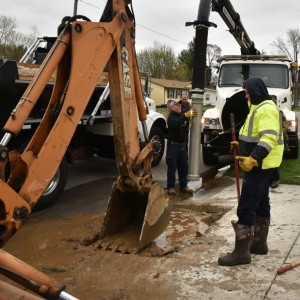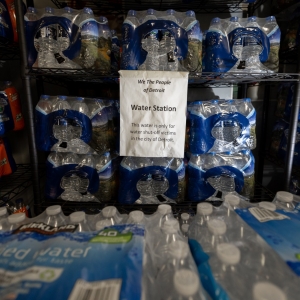This week’s episode of What’s Up With Water covers recent heatwaves in India and Pakistan and the reason some homes in Australia may become “uninsurable.” Plus, Circle of Blue reports on how rising water costs in Michigan are impacting low-income households.
Transcript
Welcome to “What’s Up With Water” – your need-to-know news of the world’s water from Circle of Blue. I’m Eileen Wray-McCann.
In India and Pakistan, recent heat waves, worsened by a changing climate, are causing dangerous water and electricity shortages. At the same time the heat is setting the stage for rampant forest fires. The Guardian reports that conditions are brutal in Turbat, a Pakistani city of about 200,000 people. Several times this spring the temperature in Turbat soared to nearly 120 degrees Fahrenheit. Despite the heat, Pakistan residents continue to endure daily electricity cuts, losing about nine hours of electricity each day. The heat wave has punished neighboring India, as well. Average maximum temperatures in northwest and central India broke records for the month of April, according to the national weather service. Electricity use also set a monthly record, due to demand for air conditioning. The hot and dry conditions have triggered thousands of forest fires. Wheat harvests have dropped by up to 50 percent in some areas, worsening fears about global food shortages amid Russia’s war in Ukraine. The severity of this and other recent heat waves in the region is a consequence of climate change. Burning fossil fuels has caused heat-trapping gases to accumulate in the atmosphere. But, as Reuters reports, the Indian government’s response to electricity shortages will contribute to the problem. India’s coal ministry said that 100 retired coal mines would reopen to in order to fuel the power generation that is needed to mitigate the effects of the heat.
In Australia, climate change could soon hit home for residents – literally. A new report finds that one in 25 Australian homes could become “effectively uninsurable” by 2030 due to climate hazards such as flooding and bushfires. In regions most affected by climate change, that number rises to more than one in 10. A property becomes “effectively uninsurable” when insurance premiums become so high the property is unaffordable to the average homeowner. Karl Mallon, a researcher with Climate Valuation, which provided data for the report, said that his team encountered premiums as high as $30,000 a year.
This week Circle of Blue reports on how rising water costs are affecting low-income households in Michigan.
Water rates are going up across Michigan as communities take on long-awaited upgrades to troubled water, sewer, and drainage systems. These investments are important for the state’s future, but they expose low-income households to financial stress. A comprehensive University of Michigan report published last year found that average water prices in the state, when adjusted for inflation, had nearly doubled between 1980 and 2018. Studies show that public officials should be concerned about rising water prices and their effect on the state’s poorest residents.
Take the case of Summer, a 58-year-old resident of Oak Park, Michigan who’s on a fixed income from disability payments. Summer said she has to be stingy with water to make her monthly budget work. Water, sewer, stormwater, and garbage collection are all part of the same bill. To keep it in the $120 range, Summer washes clothes once a week, and sometimes stretches that to every other week. With all her other bills, waste is a luxury she cannot afford.
Oak Park is among the urban areas in Michigan’s southeastern counties, places that have especially suffered the conditions plaguing water infrastructure. In the last half-century, Detroit, Flint, Pontiac, River Rouge, Inkster and others have had to contend with rising costs, aging systems, declining populations, spendthrift emergency managers, and high poverty rates. But they are not alone. The University of Michigan data reveals that rising water prices affect every corner of the state, with high-cost pockets in the Thumb and Upper Peninsula.
What happens to residents who can’t afford to pay high water rates? Late fees accumulate, adding to the financial strain. Oak Park residents who receive a shutoff notice in the mail have to pay $10 to the utility for the warning. If the water is shut off, residents pay $90 to $150 to get it turned back on, depending on the time of day that that happens. Kevin VanDeWalle, the Oak Park water supervisor, said the fees are designed to pass along the cost of operations.
Some Michigan cities also use fees. Shanir Smith is a West Bloomfield resident whose water was shut off in February for past-due bills. She said that her utility designed a three-month payment plan for her, but it has a 9 percent interest rate, which makes it harder to recover.
Though the rising cost of water is a state and national phenomenon, there is no clear-cut definition for what constitutes “affordable” water. It’s complicated because water affordability is relative. It’s about more than just the amount due on the bill, but how it compares to the receiver’s household income and to the cost of other essential expenses like food, housing, energy, and healthcare.
In the broader sense, utility leaders are realizing what advocates have been saying for years: if you want to address affordability at the household level, you have to deal with tangential issues such as the quality of in-home plumbing and a utility’s fines and fees. Dripping faucets and leaking pipes raise bills unexpectedly. High charges for late payments can put people who are struggling financially farther behind.
Assistance programs are one way to help. The 112 communities who get water from the Great Lakes Water Authority are eligible to sign up for the Water Rate Assistance Program. The program offers debt relief, bill credits, and plumbing repairs.
And there could be other assistance models coming to southeast Michigan. The Detroit Water and Sewerage Department is developing its own water affordability plan. Bryan Peckinpaugh, the department’s public affairs director, said that the plan would take a “multi-pronged approach,” but he did not provide more details. In Oakland County, the water resources commission is completing a state-funded water affordability plan for two communities, Pontiac and Royal Oak Township. Jim Nash, the water resources commissioner, said the goal is two-fold: to help those who struggle to pay an average bill and to develop a program for assisting people in emergency situations, such as job loss.
Local water leaders like Nash say the financial imbalance between the revenue a utility needs and ability of some customers to pay can only be solved by funding from the outside. In other words, state or federal dollars are needed. Said Nash, “We can’t just put all the burden on the local ratepayers. It just can’t work in the long term. It’s not sustainable.”
And that’s “What’s Up With Water” from Circle of Blue, where water speaks. More water news and analysis await you at circleofblue.org. This is Eileen Wray-McCann – thanks for being here.
Eileen Wray-McCann is a writer, director and narrator who co-founded Circle of Blue. During her 13 years at Interlochen Public Radio, a National Public Radio affiliate in Northern Michigan, Eileen produced and hosted regional and national programming. She’s won Telly Awards for her scriptwriting and documentary work, and her work with Circle of Blue follows many years of independent multimedia journalistic projects and a life-long love of the Great Lakes. She holds a BA and MA radio and television from the University of Detroit. Eileen is currently moonlighting as an audio archivist and enjoys traveling through time via sound.





